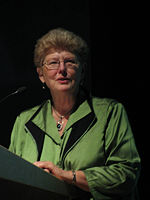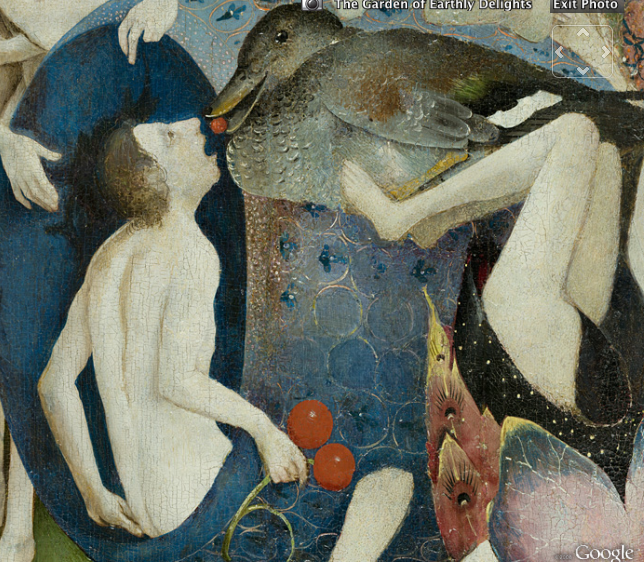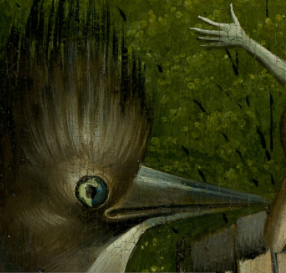
Hayles presenting at the University of Buffalo.
Rachel and I had the opportunity to attend the inaugural session of the Digital Humanities Initiative at the University of Buffalo. The day started out with a lively discussion between Gregory Crane and Stephen Ramsay (blog post coming soon!). In the afternoon, the keynote speaker, N. Katherine Hayles, gave her presentation. Hayles has always been one of my favorite scholars. Her work on electronic literature, posthumanism, and the intersections of literature and science is a main reason I became so interested in these same issues.
Her talk, entitled “Spatialization of Time in Textual, Technical and Embodied Media,” was an examination of the relationship between space and time, and how that relationship has shifted in the digital age. Her presentation, followed by a roundtable discussion, was provocative and inspirational, and I’m still trying to wrap my brain around much of what she talked about.
Hayles argued that digital technology is not only changing the way humanities (and other) scholars, artists, and students work, but also the way they think. From the inception of computing, our understanding of the computer itself has evolved. We have gone from seeing the computer as a lens through which information is displayed, to an “object of inquiry in its own right” (with the beginnings of computer science), to its current state — a “transformative technology” that has changed and influenced the way scholars and artists conceptualize their work.
Hayles’ main point was built upon previous arguments by people like German scholar Sybille Kramer, who argues that media, and digital media in particular, works as a spatialization of material that, in turn, enables that material to be manipulated in time. Unlike printed text, which is permanently fixed in both space and time on a page, allowing for very limited reader-text interaction, digital media enables the reader or audience to become the participant, to make his or her own unique intervention in or around a text or piece. This interaction depends on the fluidity of time within a fixed space.
Hayles illustrated this admittedly difficult concept with examples from literature and art. One of the most interesting of these was slippingglimpse, a joint art project by Stephanie Strickland and Cynthia Lawson Jaramillo. In this project, a user selects one of ten videos which capture moving water in various settings. The water “reads” a poem (the same poem for every video) and uses “motion capture coding that assigns the text to locations of movement in the water.”
The poem also “reads”
image/capture technologies…by sampling and recombining words of visual artists who describe their use of digital techniques – it then explores older capture technologies, such as harvesting plants for food and flax for paper;
the image-capture video reads the water, reading for and enhancing water flow patterns…to which dynamical systems return even as they continuously change.
The work succeeds in locating patterns within constant change and “turbulent motion,” as Hayles put it. This creates a recursive relationship between the piece and its audience, who are continuously exploring the ways in which the text is manipulated through their interactions with it, and its own interactions with the images. Temporality within the piece thus becomes something altogether non-linear. The poem can be read and reread in ways that abandon our perceived notions of linear time, allowing us to explore the movement and recombination of the words in a fixed space that we have selected. Space, then, becomes the independent variable in the space/time equation. The temporality of the text can be altered based on the space the reader chooses for the text.
I had a lot of fun playing with this project after the symposium had ended, and exploring the myriad ways in which the original text is recombined and can be reread in each unique spatial setting. Hayles also gave other examples from the art world — “Listening Post”, created by Mark Hansen and Ben Rubin, and David Rokeby’s “n-cha(n)t”. These installations work in ways similar to slippingglimpse, but use real-time spoken words and text. Listening Post collects fragments of text from unrestricted chat rooms and other digital public forums. The text is read or sung aloud by a voice synthesizer, and then, by way of a data algorithm, is
cycle[d] through a series of six movements, each a different arrangement of visual, aural, and musical elements, each with it’s own data processing logic.
n-cha(n)t uses words spoken by an intercommunicating set of computers and by participating audience members in an attempt to examine and synchronize the verbal flow of language. The computers converge in their communications and begin chanting, and are then broken apart and become divergent when new input is introduced by an audience member/viewer, who then also becomes a creator and artist in his/her own right. Again, this exemplifies how the computer has become a transformative technology that is re-shaping how we work and think, and how art is reweiring us to examine “stable” reality anew. Within the spaces of these installations, time and text become fluid and unfixed, allowing for a new kind of interaction between viewer/reader and piece.
From this discussion of contemporary art, Hayles moved into more scientific realms to pose the question, “How does the body know time?” Drawing on arguments from neuroscience, she argued that the brain only understands time through space. Neural complexity arises because of connections between groups of neurons that produce change in each group, which results in increased intricacy due to the re-engineering of synaptic environments. This complexity allows for the simultaneous experience of diverse temporalities. A good illustration of this might be multi-tasking: often I find myself writing a paper or class-planning in the “present” while remembering something from the “past.” Hayles’s conclusion is that linear time is “an illusion perpetuated by time measurement,” which is in turn perpetuated by what she terms the “colonization or globalization of time,” an idea based in capitalist society’s attempts to harness time to increase profits and efficiency. She noted that a 24-hour basis of operations is now the norm for many companies, who have indexed time to a global standard and have “sutured” it to the local (I’m really enjoying her use of this metaphor here because it gets at a certain violently unnatural quality inherent in Western ideas of time).
The internet, though, is changing all of this, and bringing about a reconceptualization and reenactment of space/time through digital technologies. According to Hayles, “the computer has enabled a collapsing of space, [and there is no longer] a need to navigate space.”
This is best seen with projects like hypercities, in which space becomes what Hayles terms “a container for different temporalities.” This project provides cities a chance to “preserve their time and memory” through interactive mapping technologies that allow a user to explore different layers of time within the boundaries of a given city. Mapping here becomes an exercise in temporalization as it is defined through the user’s choice of a space.
The possibilities this re-imagined space/time relationship opens up for digital projects in the humanities will continue to transform scholarship as those projects continue to evolve and become increasingly interactive, recursive, and revolutionary. Hayles’ talk makes me excited to see, and participate in, the future of humanities computing.
-Ali McGhee
Continue reading




